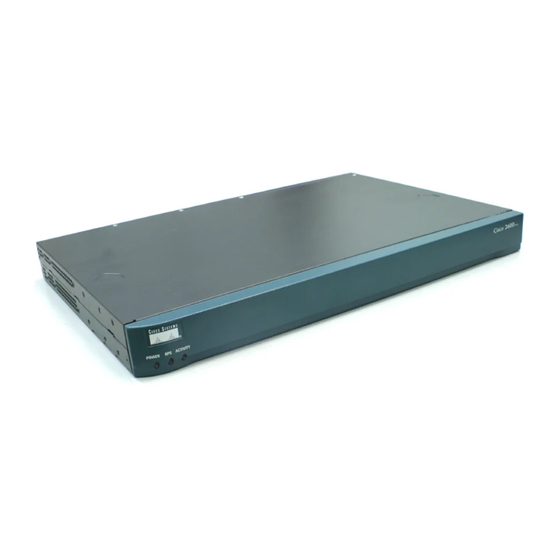Cisco 1721 - VPN Security Router Bundle 사용자 설명서 - 페이지 29
{카테고리_이름} Cisco 1721 - VPN Security Router Bundle에 대한 사용자 설명서을 온라인으로 검색하거나 PDF를 다운로드하세요. Cisco 1721 - VPN Security Router Bundle 48 페이지. Troubleshooting guide
Cisco 1721 - VPN Security Router Bundle에 대해서도 마찬가지입니다: 하드웨어 설치 매뉴얼 (11 페이지), 빠른 시작 매뉴얼 (17 페이지), 데이터시트 (12 페이지), 하드웨어 문제 해결 (12 페이지)

Physical Security
The router is entirely encased by a thick steel chassis. WIC slots, on-board LAN connectors,
Console/Auxiliary connectors, power cable connections, and power switches are provided on the router.
Specific portions of the chassis may be removed to allow access to the motherboard, memory, and
expansion slots.
Any WIC or other module slot, which is not populated with a WIC or a module, must be populated with
an appropriate slot cover in order to operate in a FIPS compliant mode. Slot covers are included with
each router, and additional covers may be ordered from Cisco. The same procedure mentioned below to
apply tamper evidence labels for WICs and other modules must also be followed to apply tamper
evidence labels for the slot covers.
Once the router has been configured in to meet FIPS 140-2 Level 2 requirements, the router cannot be
accessed without signs of tampering. To seal the system, apply serialized tamper-evidence labels as
follows:
To apply serialized tamper-evidence labels to the Cisco 1721:
Clean the cover of any grease, dirt, or oil before applying the tamper evidence labels. Alcohol-based
Step 1
cleaning pads are recommended for this purpose. The temperature of the router should be above 10°C.
Step 2
Place the first label on the router as shown in
that the one half of the tamper evidence label covers the top-half of the right side of the enclosure and
the other half covers the bottom-half of the right side of the router. Any attempt to remove the enclosure
will leave tamper evidence.
Place the second label on the router as shown in
Step 3
so that the one half of the tamper evidence label covers the top-half of the left side of the enclosure and
the other half covers the bottom-half of the left side of the router. Any attempt to remove the enclosure
will leave tamper evidence.
Place the third label on the router as shown in
Step 4
that the half of the label covers the enclosure and the other half covers the left WAN interface card slot.
Any attempt to remove a WAN interface card will leave tamper evidence.
Step 5
Place the fourth label on the router as shown in
so that one half of the label covers the enclosure and the other half covers the right WAN interface card
slot. Any attempt to remove a WAN interface card will leave tamper evidence.
Step 6
The labels completely cure within five minutes.
To apply serialized tamper-evidence labels to the Cisco 1760:
Step 1
Clean the cover of any grease, dirt, or oil before applying the tamper evidence labels. Alcohol-based
cleaning pads are recommended for this purpose. The temperature of the router should be above 10°C.
Place the first label on the router as shown in
Step 2
that the one half of the tamper evidence label covers the right side of the enclosure and the other half
covers the right side of the front of the router. Any attempt to remove the enclosure will leave tamper
evidence.
Place the second label on the router as shown in
Step 3
so that the one half of the tamper evidence label covers the left side of the enclosure and the other half
covers the left side of the front of the router. Any attempt to remove the enclosure will leave tamper
evidence.
Cisco 1721, 1760, 2621XM, 2651XM, 2691, 3725, and 3745 Modular Access Routers and 7206-VXR NPE-400 Router FIPS 140-2 Non-Proprietary
OL-6083-01
The Cisco 1721, 1760, 2621XM, 2651XM, 2691, 3725, 3745, and 7206 VXR NPE-400 Routers
Figure
20. The tamper evidence label should be placed so
Figure
20. The tamper evidence label should be placed
Figure
20. The tamper evidence label should be placed so
Figure
20. The tamper evidence label should be placed
Figure
20. The tamper evidence label should be placed so
Figure
20. The tamper evidence label should be placed
29
